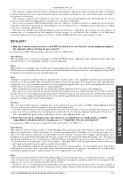Page 721 - SAIT Compendium 2016 Volume1
P. 721
CASE DIGEST 2009–2010
The taxpayer company had entered into agreement with another company in terms of which the latter would mine foskorite and deliver it to the taxpayer which would pay the mining and transport costs, and would acquire ownership of the foskorite so delivered.
The taxpayer company did not intend to sell such ore, but extracted phosphates and other minerals by various processes, after which it sold phosphate concentrates to customers world-wide.
In a revised assessment, SARS included in the taxpayer company’s taxable income the accumulated cost incurred by it in terms of the above agreement, as representing the cost of closing stock as contemplated in the de nition of ‘trading stock’ in s. 1 of the Income Tax Act.
The issue was whether the foskorite dumps in question had been acquired by the taxpayer for ‘the purpose of manufacture’ as contemplated in that de nition. On the evidence, it was held that the stockpiles of ore did indeed constitute trading stock for the purposes of the Act, and that SARS had been correct in treating it as such.
2010–2011
1. May the Commissioner, in terms of the VAT Act and the Income Tax Act, obtain judgment against the taxpayer without raising an assessment?
[Commissioner SARS v Fastmould Specialist CC (2011) 73 SATC 284]
Introduction
The respondent was a taxpayer responsible for VAT and PAYE returns. Although it had submitted returns re ecting amounts due by it to the appellant, it failed to pay such amounts.
Facts
The taxpayer was a manufacturer of plastic injection mould products and was responsible for the submission of VAT and PAYE returns. It had submitted the tax returns in which it had indicated amounts due by it to the appellant, being SARS, but had, however, failed to pay the amounts indicated.
Issue
Attempts to negotiate payment with the appellant were unsuccessful as the appellant found the proposed payment structure to be unacceptable. The respondent nevertheless made part payment of the amount due. The appellant then noti ed the close corporation that it intended to obtain a judgment against it in respect of the outstanding debt. However, SARS did not raise an assessment prior to taking judgment.
After a judgment was obtained, the respondent successfully applied for the rescission of the judgment.
The court a quo was faced with the question whether the Commissioner was entitled in terms of the VAT Act and the Income Tax Act to obtain judgment against the taxpayer without raising an assessment and hence whether the magistrate was correct in rescinding the judgment for the reason that the appellant had not issued an assessment for the amounts due prior to making application for the judgment.
Decision
The court rejected the taxpayer’s argument that an assessment was necessary prior to SARS seeking judgment. It held that once a debt is due, the enforcement/recovery procedure must follow.
It would completely frustrate the law, namely the prompt collection of tax due to the scus in terms of the taxpayer’s own records, if it was not entitled in those circumstances to invoke the tax recovery procedure provided in the relevant Acts.
The court upheld the appeal and set aside the rescission of the judgment with costs.
2. Does the issue by a company of its own shares in consideration for a trade mark constitute ‘expenditure actually incurred’ for purposes of s 11 (gA) (iii) of the Income Tax Act?
[Commissioner SARS v Labat Africa Ltd [2011] JOL 27986 (SCA); 72 SATC 75]
Introduction
The taxpayer, under its former name of Acrem Holdings Ltd, purchased ‘the entire business operations’ of Labat- Anderson (South Africa) (Pty) Ltd in terms of a written agreement dated 15 February 1999. Its effective date was 1 June 1999. The business operations of Labat-Anderson were de ned to include all its tangible and intangible assets including, more particularly, the trade mark. In terms of clause 6 of the agreement, under the heading ‘sale’, the taxpayer ‘purchased’ the business ‘for a consideration’ of R120 million, ‘discharged by the issue to Labat-Anderson’ of 133 333 333 Acrem shares ‘at an issue price of 90 cents per share’. (Although called a sale, the agreement was not a sale because a sale requires payment in money and not consideration in kind.)
The clause further provided that the ‘purchase price’ was to be apportioned as to the net tangible assets at the values re ected in the accounts, then to the value of the trade mark and name in an amount as determined by an independent and suitably quali ed valuator, and the balance was to be apportioned to goodwill.
Issue
The issue before the full bench of the North Gauteng High Court was the question as to whether the issue by a company of its own shares in consideration for a trade mark constituted ‘expenditure actually incurred’ by the company for the purposes of s 11 (gA) (iii) of the Income Tax Act 58 of 1962.
Section 11 (gA), as it read during the relevant 2000 tax year, provided for the amortisation of the cost of the acquisition of intellectual property rights at the rate of four per cent per annum. Taxpayers who incurred any expenditure in acquiring
SAIT CompendIum oF TAx LegISLATIon VoLume 1 713
CASE DIGEST 2010-2011


